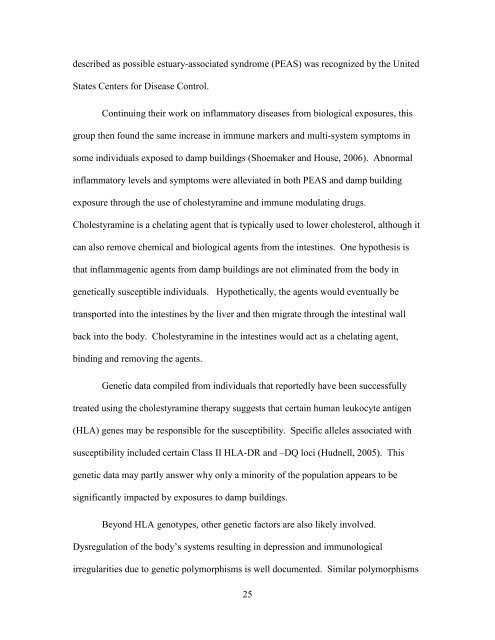INDUCTION OF DEPRESSION BY EXPOSURE TO DAMP ...
INDUCTION OF DEPRESSION BY EXPOSURE TO DAMP ...
INDUCTION OF DEPRESSION BY EXPOSURE TO DAMP ...
You also want an ePaper? Increase the reach of your titles
YUMPU automatically turns print PDFs into web optimized ePapers that Google loves.
described as possible estuary-associated syndrome (PEAS) was recognized by the United<br />
States Centers for Disease Control.<br />
Continuing their work on inflammatory diseases from biological exposures, this<br />
group then found the same increase in immune markers and multi-system symptoms in<br />
some individuals exposed to damp buildings (Shoemaker and House, 2006). Abnormal<br />
inflammatory levels and symptoms were alleviated in both PEAS and damp building<br />
exposure through the use of cholestyramine and immune modulating drugs.<br />
Cholestyramine is a chelating agent that is typically used to lower cholesterol, although it<br />
can also remove chemical and biological agents from the intestines. One hypothesis is<br />
that inflammagenic agents from damp buildings are not eliminated from the body in<br />
genetically susceptible individuals. Hypothetically, the agents would eventually be<br />
transported into the intestines by the liver and then migrate through the intestinal wall<br />
back into the body. Cholestyramine in the intestines would act as a chelating agent,<br />
binding and removing the agents.<br />
Genetic data compiled from individuals that reportedly have been successfully<br />
treated using the cholestyramine therapy suggests that certain human leukocyte antigen<br />
(HLA) genes may be responsible for the susceptibility. Specific alleles associated with<br />
susceptibility included certain Class II HLA-DR and –DQ loci (Hudnell, 2005). This<br />
genetic data may partly answer why only a minority of the population appears to be<br />
significantly impacted by exposures to damp buildings.<br />
Beyond HLA genotypes, other genetic factors are also likely involved.<br />
Dysregulation of the body’s systems resulting in depression and immunological<br />
irregularities due to genetic polymorphisms is well documented. Similar polymorphisms<br />
25


